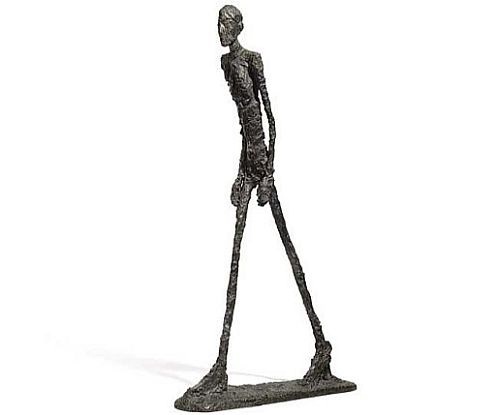
| Volume 31 #5 | March/April 2015 | |
I have recorded daily pedometer steps in a spreadsheet for three years, and I recently posted the following information on my facebook timeline.

I calculated my 2014 activity from pedometer data.
743 miles folk dancing ... move to the music!
The minimum goal is 10,000 steps per day.
10,100 steps on 135 non-dance-days
16,500 steps on 230 dance-days
14,100 steps daily average with 4.4 dance-days per week
2587 total miles per year (100%)
1844 non-dance miles per year (71%)
743 dance miles per year (29%)
Wearing a personal pedometer appears to be catching on with the general public and also with dancers. We Scottish dancers are aware of the incidental health benefits of dancing. Such a fun activity to dance for improved health!
Sometime in my seventy second year I decided to take up Scottish Country Dancing. My Scots genes must have kicked in belatedly as I embraced this wonderful dance tradition of country folk. It looked simple enough, with pleasant people and magical music – surely I was up to this?
Scottish Country Dance, not to be confused with Scottish Highland dancing, began we are told, during the Renaissance among the wealthy classes and during later centuries, especially the 18th century. This quicker dance form was a bit of relief from the more formal dances of that time. Most likely it began from early British forms of similar country dancing which also gave rise to the contra-dance and the ceilidh, an unpronounceable Gaelic word, but a wow of a party.
There are basically two kinds or categories of this dance: quick time, jigs and reels and hornpipes, and the Strathspey, a slower, more stately form during which time the dancers' hearts return to something closer to normal beating. More about this later.
The basic dance steps, of which there are only three or four, are easy-peasy. The Pas de Basque, the quick step and the slip-step. Then there is the slower Strathspey step, sedate and lovely to see. What could be easier?
However, as I soon learned, during Lesson #1, it was the patterns which could catch you up, so to speak, and reduce a fairly smart and clever person to tears and blubbering at the end of thirty two bars of music. These patterns, confusing beyond my worst dreams, were similar in complexity to a middle eastern mosaic made up of a million tiny tiles . . . which we had to memorize . . . and repeat eight times.
So there we were, a dozen or more hardy souls, Scots or na, hopping around the smooth wooden floor of the old town hall every Friday evening. Just hearing the sprightly fiddle and accordion tunes and all, made your toes itch to be moving, to be dancing! But, I soon found that my seventy-two year old body was not what I’d thought it was. My heart, as I danced on and on, would be thumping in my chest, my breath coming in ragged bursts out of my tightly clenched lips, sweat sliding down my temples. The exertion was astounding! And here was my partner, Tom or Martin or Holly, or some other experienced dancer, floating about, lithe and expert, feet leaping lightly and grinning all the while, not apparently even breathing hard. By the end of the "The Piper and the Penguin" reel, I was panting. How embarrassing if I fell over flat on my exhausted face?
After a few weeks of this exertion, I realized I must train harder, so I signed up for a Zumba class twice weekly on Monday and Wednesday - a strenuous workout of forty five minutes each time, with much perspiration and more jumping about. I lost ten pounds and my sartoris and quadriceps muscles were looking more promising, but still I was hurting during the Scottish dance workout. I noticed that our instructor, Linda Mae, bless her dancing heart, had begun to bring a resuscitation kit to class and often looked worriedly in my direction.
There are over 15,000 documented Scottish Country dances and Linda Mae is taking us through them, one by one. And since we are taught three dances each Friday evening, we will need 5,000 more lessons to learn all of them. However, we never repeat any of the dances which is very mysterious to me. We also learned the proper etiquette of the "Bow" and the "Curtsey" and how our feet should be, that is, in the first Ballet position just waiting to spring forth! Next, the proper hand holds were taught, such as the Promenade hold and the Elbow Grip, and the Allemande hold, or one I call, "Holding on For Dear Life" when we swirl around in a circle of eight or more!
Out teacher, Linda Mae, light as thistle-down on her toes, would introduce a new dance thus:
"New first couple cast off and go below second couple in a half-figure of eight, then four hands around and returning to their original place." Lindamae would then ask hopefully, "Is that clear?" I smiled and nodded. "Then," she went on, "third couple and second couple do back to back and then hands across with their corners ending up in fourth and third position. Are we clear on this?", she asked. I would nod vigorously and smile knowingly, not grasping the pattern at all. Then we would practice this all over again, to music.
After almost a year of classes, I was still in the novice category; the secret of this dance seemed just beyond my grasp. My fellow dancers gave smiles of encouragement or verbal clues or pointing of fingers as in, go here, go left, go right! They were so kind.
I soon learned that something called "the progression" of the figures was just as bewildering as the patterns. For example, after one repetition, the 1st couple ends up at a different place in the longwise four couple set. So, the order of the couples would be 1,2,3,4, then, 2,3,4,1, then 3,4,1,2, and finally 4,1,2,3 and maybe repeat the 1,2,3,4 again! Are you with me? At this point, the dance would stop and my head would be swirling or was this cardiac arrest? Some of the newer Scottish dances also have, I’m told, a palindromic structure. "The White Heather Jig" is this type, where if I'm right, the dance looks the same coming or going, after which the dancers gulp down a shot of neat Scotch whiskey in order to recover.
About this time, I began to read more about this dance form: "A well-executed step involves quite some time and dedication and also a certain level of physical fitness." How true, how true! Perhaps, I thought, I need some additional training? Possibly I should go to the gym and work out on Tuesdays and Thursdays, or take up running on Saturdays and Sundays? I could build up my Tibialis anterior and the Gracilis muscles in my legs. This schedule would leave little time for eating or reading or being with my family, but time was running down, and so was I.
But, here was some heartening news! In 2010, the University of Strathclyde in Scotland, did a study of the health benefits of Scottish Country dancing among folks sixty to eighty five years of age. When compared to like-aged people who regularly did swimming, walking or other fitness classes, the Scottish dancers were shown to have more agility, stronger legs, and be able to walk more briskly, not to mention, I would hope, improved vascular and lung health; this last supposition, is mine. Scottish country dancing is reputed to burn about 800 calories/hour!
So, I joined a local gym twice a week and worked with a physical fitness specialist known to one and all as "The Hulk." He helped me on the Stair Master machine, the Ab Crunch and the Elliptical Trainer. It turned out that he was from the clan Macleod. "Oh, you poor wee lassie.", he commiserated. He understood perfectly what I was up against on the Scottish dance floor. On Saturdays, I joined a local running group and was often seen running fourteen miles from the top of Larch Mountain, 4,500 feet, to the base, with my club "The Red Lizards", most of whom were in their thirties or forties . My lung capacity was soon the envy of many of my running friends.
So here I am, now seventy four years old, still going to class, and still enjoying it, and still in the beginning stages. But I take my battle cry from my favorite Scots poet, Bobbie Burns, who, writing one of his most famous songs in 1793 to commemorate the Battle of Bannockburn which had happened centuries earlier, said:
Scots Wha Hae wi Wallace bled,
Scots whom Bruce has often led,
Welcome to your gory bed,
Let us do or dee!
Well, I’ll not go to my "gory bed", though a good night's rest after Scottish dancing is very beneficial. But, I will do or dee!* Whoops! Gotta run, gotta dance!
* "Do or die"
Don't worry, lest the reader think that we really do work our class attendees to death, this is of course rather tongue in cheek. ~ The Editor
As a young man, Douglas wanted to win a step dance contest, known as "buck dancing", at the Saturday night Community Barn Dance. He practiced as his Grandmother had instructed. Then when it was his turn and he asked for the tune she advised, closed his eyes, and remembered her advice about heel and toe and even threw in a few flat foot steps. A man in the crowd shouted "Someone get a bucket of water! That boy is setting the 'floor' on fire!" Douglass opened his eyes, looked down, and saw sparks shooting from the soles of his shoes -- the steel taps of his shoes were striking the nails in the wood. With the crowd whooping and shouting, Douglass won the competition! Later he honored his Grandmother with a gift purchased from his winnings.
It is a touching tribute of a 13 year old boy to his "Mamaw". If you would like to read the entire story, please ask, and I will bring it to class.
(Excerpted from a story by Douglas Scott Clark, Maryville, Tennessee)
As many of you know, I've a basic knowledge of the Ghàidhlig language which I've learned over the years in concert with books, recordings, and the able assistance of Donald MacDonald, a native son of the Island of Harris, who I've learned just today is sadly now no longer with us or, chaochail e, he passed away from the consequences of asbestosis which he acquired working on refurbishing ships in his younger days in Glasgow shipyards. His pages are being kept on line by, I assume, a family member at http://www3.sympatico.ca/donaldmacdonald/index.htm I have, when time is available, been trying to keep the language in my head and air mo theanchaidh literally "on my tongue" through listening to Caithream Ciùil daily, a program from Radio Nan Gaidheal, part of BBC Alba, the Scottish Gaelic service, which can be heard at http://www.bbc.co.uk/radionangaidheal as well as keeping a weekly schedule over Skype with a former fellow student of Donald's, Robert (Mac) MacKenzie out of Calgary, Alberta Canada.
This last Saturday, February 21st of this year, I participated in an event hosted by Slighe Nan Gaidheal, meaning the way of the Gael or Gaelic speaker, called "Zero to Gaelic in Portland." This was hosted by a familiar venue to many of us, the Renaissance School of Arts and Sciences. http://www.renaissanceschoolportland.org/ I signed up for the intermediate level though there was a range available from no Ghàidhlig at all to advanced. The atmosphere was quite relaxed thanks to the beautiful weather, the excellent facilities, and the good and gentle hearts of those participating. The latter, of its importance I can't stress enough, is key to facilitating the comfort level needed to ease the learning process. Before classes began, there were greetings and a bit of socializing, a time of announcements, an outline of classes, and assurances that the attendees would not be locked into a particular level if any found either that they were in a class too advanced for their abilities or were in a class that was below their level.
A program called "Language Hunters" was used to help facilitate learning. I'm not aware if this method has been used with Scottish Gàidhlig though it is generally used to help recover endangered languages from around the world. The facilitator of this was Brían Ó hAirt, a teacher of Irish Gaelic in the Portland area. It uses games and gestures to help cement the language in one's mind in ways that studying a language in a purely dry academic setting doesn't accomplish as effectively. http://languagehunters.org/ Seumus Gagne, the director of Slighe Nan Gaidheal taught in the beginning level and a local man named Geoff Frasier, whom some of us experienced leading a Burns Supper for the Masonic Lodge in south east Portland described elseware in this newsletter, was the primary instructor for the intermediate to advanced levels. Though he is only newly familiar with the Language Hunters method of teaching, he was quite able in this rôle.
Though I found my abilities a bit above the level of my selected class, one thing I found quite helpful and interesting was sung studying Gàidhlig This has been an obstacle for me as academic or spoken Gàidhlig is more bound to the rules and grammar of the language while songs, òrain don't follow those rules as rigidly and often use idioms and words that are not used in modern Gàidhlig. We spent some time singing a common puirt a' beul, or mouth music tune named Cì 'n Fhidheall "Give Me The Fiddle." The lyrics of this song were distributed amongst the class members and in addition to reacquainting ourselves with the tune, worked through the lyrics in such a way as to understand what is being said literally, what parts of that were idomatic, used to maintain rhythmic flow, used older words, or had grammatical connotations like genetive case constructions and the like. Here is the tune, both in lyrical form and with audio:
Cì 'n Fhidheall
[Sèisd:]
'S ò cì 'n fhidheall fair an fhidheall
Cì 'n fhidheall fair an fhidheall
Cì 'n fhidheall fair an fhidheall
Cuir an fhidheall air a' bhòrd.
[2 turas:]
'S toigh leam Bean Thobhtaiche Dubha [x 3]
'S toigh leam piuthar Ràghnaill Oig.
Nighean Ràghnail Ruaidh thu [x 3]
'S piuthar ghuanach Ràghnaill Oig.
Chunna mi 'san Dùn thu [x 3]
Dèanamh cunntas ri Mac Leòid.
The tune is available here as part of a tune set in the version most familiar to myself: https://www.youtube.com/watch?v=6WiFHLm5rpY
Now you have a little flavor of what it means when I say during a class that a particular tune in a tune set in class is of Gàidhlig origins. Suas leis a' Ghàidhlig! May Gàighlig be stronger!
The Heather Clan o th' Masonic Royal Order of Scotland hosted eight local dancers at their Burns Dinner January 23rd in Portland for an evening of Scottish Merriment.
After a delicious dinner which included traditional neeps, tatties, and haggis, punctuated with toasts and tributes, the guests were piped into the council room to enjoy the evening's entertainment. Geoff Fraser, Celtic scholar and MC, gave an expressive rendition of Tam o’ Shanter. The Portland Police Highland Guard Pipes and Drums filled the room with Scottish tunes, and also enjoyed sharing other styles of pipe music, some quite syncopated and jazzy, accompanied by conga drum, electric guitar, fiddle, and other instruments. Other performances featured folk singer Lori Kuechler, Elizabeth Nicholson on Celtic harp, and Eileen and Paul Walter on fiddle and guitar.
The highlight of the evening was, of course, the Scottish Country Dancing. The team of Holly Gibson, Marge van Nus, Layne Russell, Martin MacKenzie, Susan and John Shaw, and Tom and Liza Halpenny gave their joyous best to present a jig, strathspey, and reel, along with information about SCD and an invitation for others to attend local classes.
The evening was a monumental undertaking by this enthusiastic Masonic order, and it certainly seemed as if it was enjoyed by all who attended. For us, what could be better than to partake of a sumptuous feast, to watch other talented performers, and on top of it all, to get to DANCE?
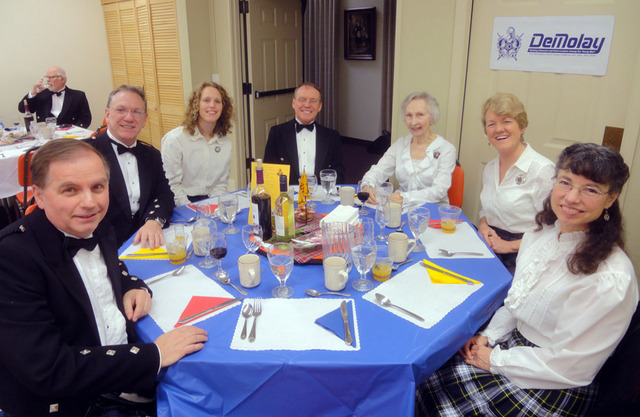
|
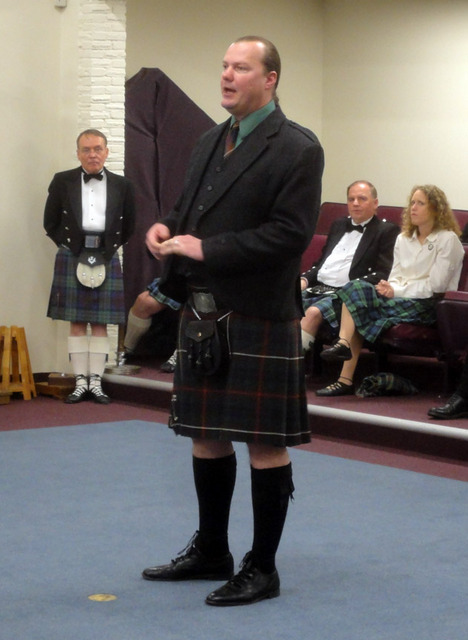
|
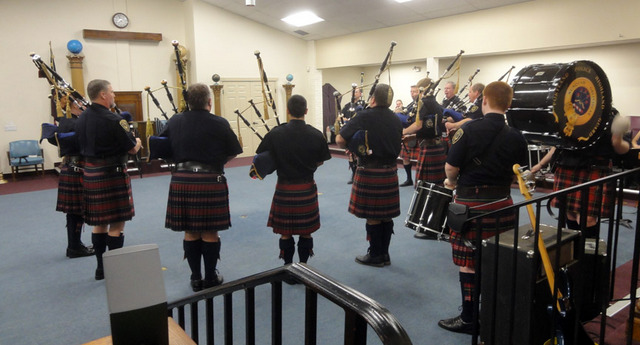
|
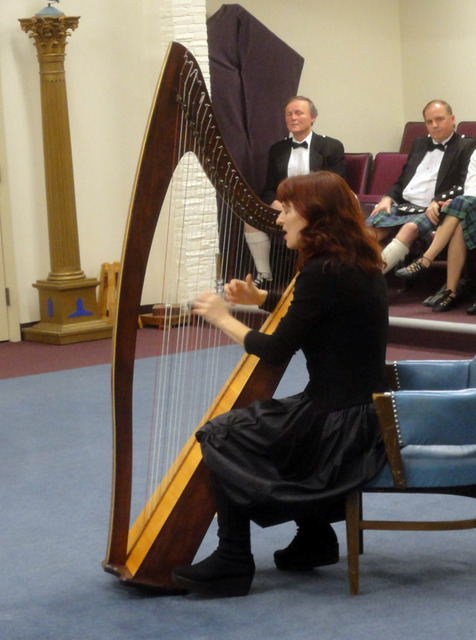
|

RSCDS invited Young Dance devisors to submit a dance that will be judged at the upcoming 2015 Spring Fling event. Young devisors submitted 46 dances and they are being trialled by 33 Young Dance groups from around the world, including: Australia, New Zealand, Jamaica, Russia, Canada, America, Continental Europe and the UK. The final short list of dances will be trialled in London at Spring Fling 2015.
Branch teacher committee members Linda Mae and Liza taught six submitted dances to our own group of young dancers on January 31: Josh, Antonya, Darrick, Lilyana, Maggie, Caitlin, Elisabeth, and Holly. Dancers voted and commented on the quality of each dance. The Branch was the first to submit trialling results to RSCDS, before the March 15 deadline.
We can view the dancers in action. https://www.youtube.com/watch?v=yzHRVrbVG0I

RSCDS retired Membership Secretary Elspeth Gray was interviewed by Robbie Shepherd, host of the weekly BBC music radio programme "Take the Floor". We can listen to the interview and learn about Elspeth's music preferences, RSCDS career, thoughts about the future, and response to the host's question whether she will take up Scottish country dancing. http://www.rscds-swws.org/news/stories/ElspethGrayInterview.mp3 Note, this might take a bit of time to load depending upon the speed of your Internet connection.
I travelled to Edinburgh January 8-12 for meetings with the elite leaders of the RSCDS world, for the Strategy session of the Management Board and the three committees. The main goal of the meeting was to identify methods to increase the number of Scottish country dancers worldwide, and indirectly to increase the number of RSCDS members.
I arrived Friday morning and visited Headquarters at 12 Coates Crescent. I met several staff whose names I had read over the years. I also met Mike Greenwood, the new Digital Communications Officer, and we discussed some ideas for a couple hours.
I departed HQ and walked to the nearby Tune Hotel to check in and take a nap. My room had a compact space without windows, so I was easily able to fall asleep. I awoke and departed into the 4:00pm dusk with street map in hand to explore the neighborhood and find my way to the Radison Blu Hotel on the Royal Mile, site of the next day's Strategy meeting. It was fascinating to wander through the winding streets among the stone architecture buildings, and try to recover after becoming lost, an important Scottish dance skill.
I headed out Saturday for an early morning walkabout, with Edinburgh Castle centrally in view, and arrived early for the meeting. I enjoyed becoming acquainted with everyone as they arrived, and I was able to talk with almost all 35 attendees during the day. Raphaëlle Orgeret from France, Anselm Lingnau from Germany, staff member Mike Greenwood from Canada, and myself from USA were the four international attendees who spoke with an accent. After a short meeting of the Management Board, the main meeting began. Chairman Jim Healy and Chairman-Elect Helen Russell introduced the agenda, and the meeting divided into five breakout groups who gathered ideas for one hour. After lunch, each group reported its results.
Retiring Membership Secretary Elspeth Gray was on hand to record the meeting notes. During lunch, Jim Healy presented Elspeth with a gift and gratitude from the Society for Elspeth's contributions over the past 14 years. Six past chairmen also attended, which contributed to the festivity.
At the conclusion of the meeting, everyone said their goodbyes and ventured outdoors to observe that the dynamic weather had become breezy with showers. I felt right at home, with weather similar to the Portland-Vancouver area.
With all the SCD teaching and music talent in the meeting, it would have been fun for everyone to do some Scottish dancing. Moira Thomson informed me about the Trinity Ball on Saturday evening. I was casually dressed for the occasion, but I walked several miles to the ball location and observed the dancing. Event organizers Colin and Joan Tyler welcomed me to observe the ten dancing sets and band consisting of accordion "box", fiddle, and drums. I noticed four dancers whom I had met earlier in the RSCDS Strategy meeting. I had a cordial conversation with co-MC Margo Priestly, who described what it's like to teach her advanced SCD class with the aid of a musician.
The dynamic weather continued Sunday as I headed out, after a hearty Scottish breakfast, for a hike north to the Firth of Forth and Ocean Terminal. I followed my street map and only became lost once. The route took me through the Royal Botanical Garden that relocated to the current site around 1800 and is maintained by a staff of 50 gardeners. I finally reached the water and took refuge in a large shopping mall that is the site of the Royal Yacht Britannia. After sufficient rest, I returned to the hotel via double decker bus line number 22.
I rode the tram from the hotel to the Edinburgh airport Monday morning and boarded the airline for the trip home. All in all, a pleasant and memorable three days of introduction to Edinburgh and RSCDS.

|

|
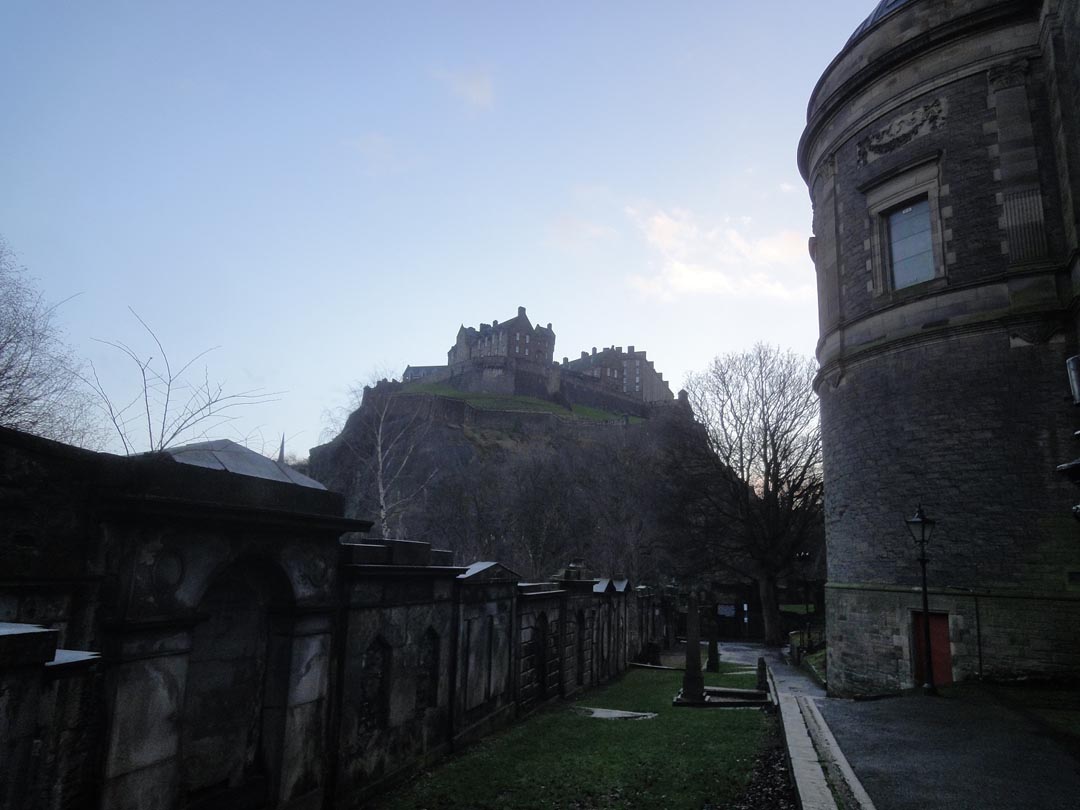
|
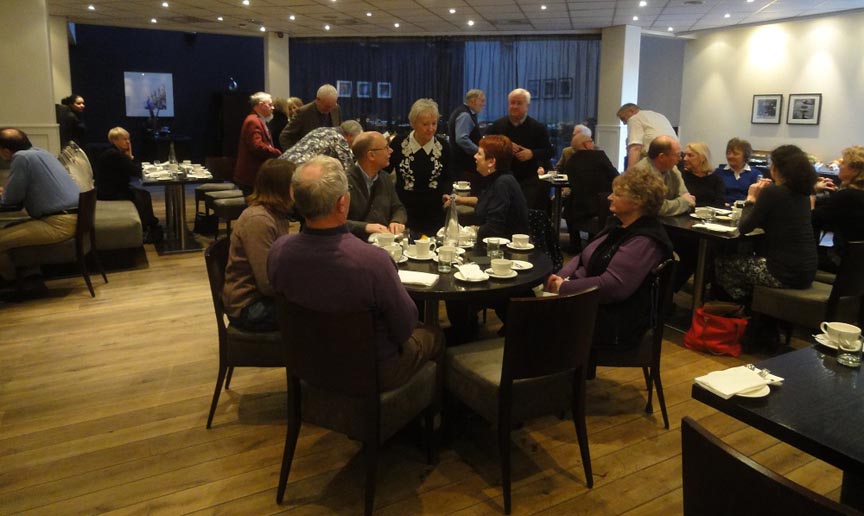
|
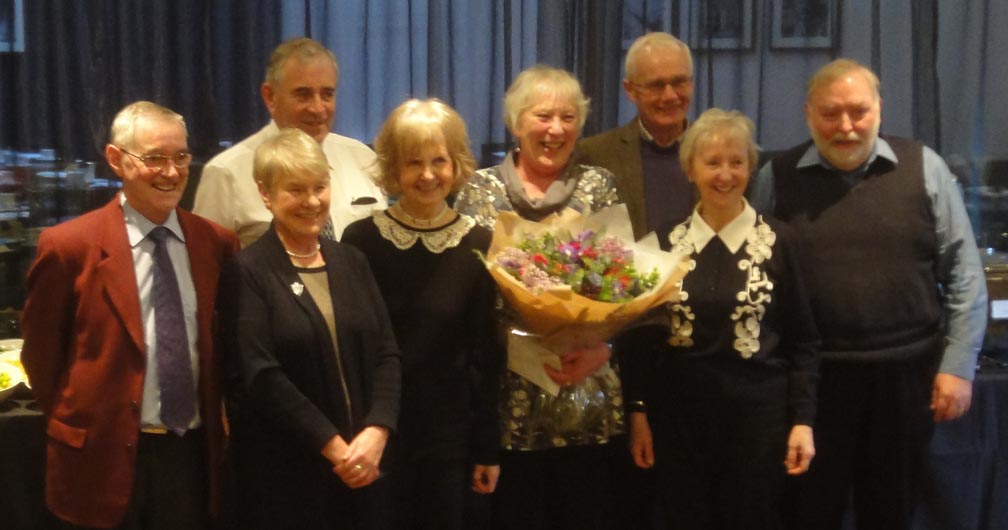
|
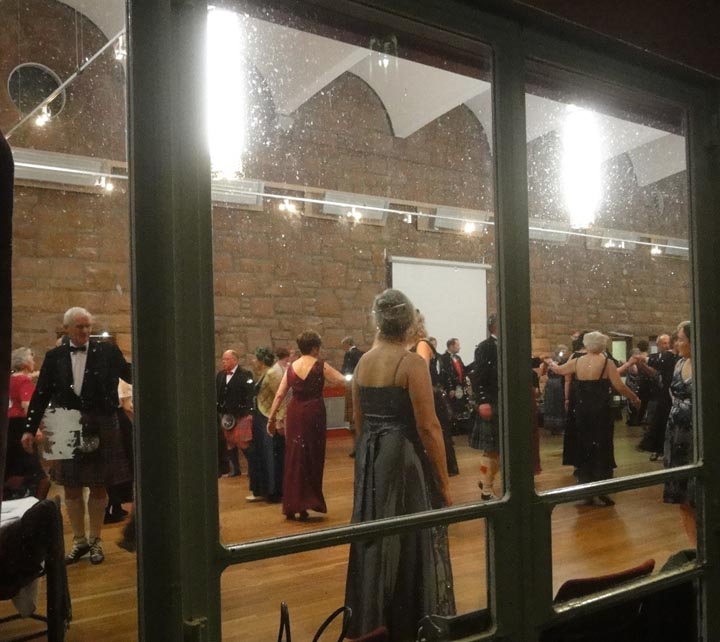
|

|
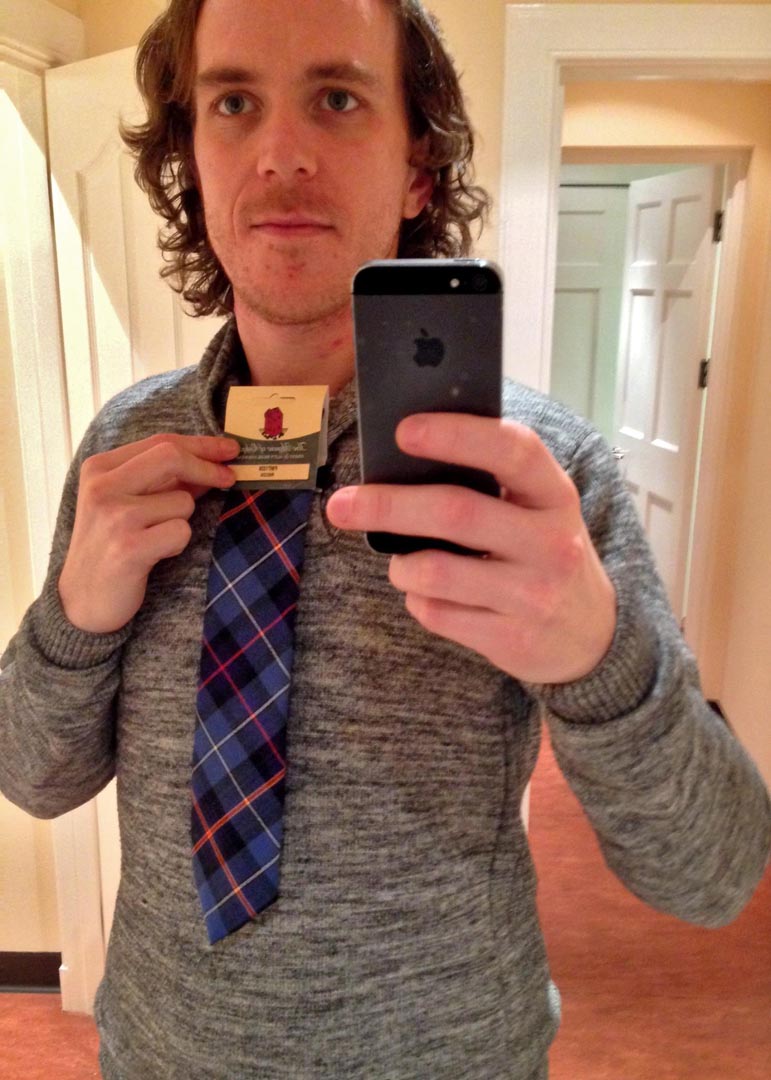
|
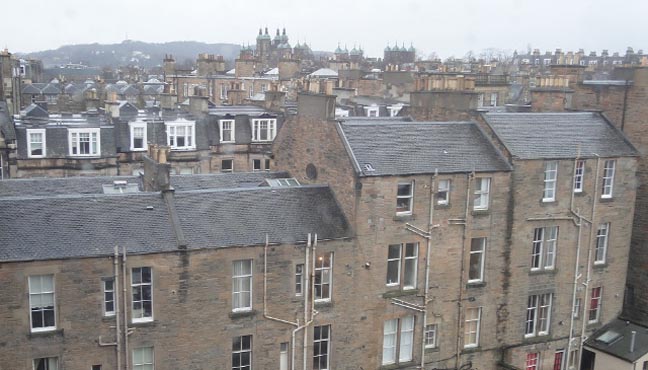
|
Calendar of Events | ||||||||||||||||||||||||||||||||||||||||||||||||||||||||||||||||||||||||||||||||||||||||
|
|